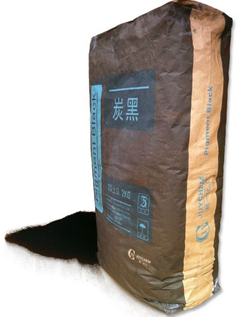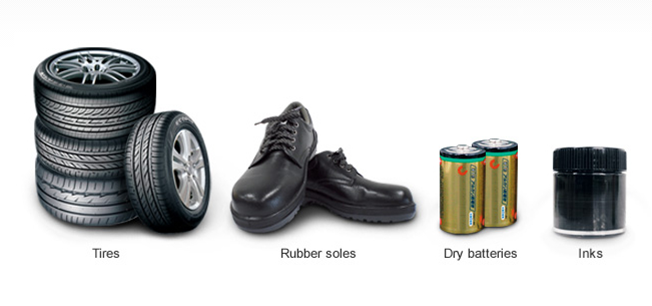What is Pigment Carbon Black ?
Carbon black as pigment that used in coatings & paints, inks, plastics and etc is called pigment carbon black. Pigment carbon black can also provide function of conductivity, electrostatic shielding, shielding against UV, preventing resin’ aging in application for coatings & paints, inks, plastics. Hence, in a broad sense pigment carbon black is called special carbon black (as distinguished from carbon black that used in rubber).
According to the forecast and appraisal of Notch Group in the USA, the productive capacity of carbon black in the world in 2007 is 10.16 million tons and it can grow to more than 12 million tons in 2012. 90% are carbon black for use in tire and rubber industry. The rest part about 10% is used as pigment.

Physical Parameter of Carbon black pigment.
a. Particle diameter means the diameter of a single(random) particle generated in the burning of a sort of oil. Average particle diameter means extracting some particles of limited weight or unit weight and calculating the average particle diameter.
b. specific surface area means the area that a unit weight powder occupys. This figure is related to particle diameter.
c. DBP absorption value, means the oil absorption volume of unit weight. In general, the less absorption value, the better glossiness in pigment product.
d. PH, the best is neutral, that is PH≈7. That would be good to the plastic performance.
e. Blackness, some factories measure the blackness with iodine absorption number. The higher iodine absorption number , the higher blackness.
f. Color strength, means the percentage of the carbon black coloration in production process.
Characteristics of Pigment Carbon Black
1. Comparing with other pigment, carbon black is better in tinting strength and hiding power.
2. Comparing with other pigment, carbon black is good in durability on heat, chemicals and light.
3. Carbon black is difficult to disperse stably in the organic resin system because its particle size only ranges from a few nanometers to dozens of nanometers, and porosity reaches 90%, moreover, it is inorganic materials. However, carbon black after strict control and treated with special craft can be well dispersed in paints, inks and plastic system.
4. Comparing with rubber carbon black, pigment carbon black has higher and more specific requirements in blackness、tinting strength、surface activity、conductivity、ash、light transmittance of toluene、dispersibility、fluidity and other technical indexes.
Application of Pigment Carbon Black
Traditionally, Pigment carbon black has been used as a reinforcing agent in tires. Today, because of its unique properties, the uses of Pigment carbon black have expanded to include pigmentation, ultraviolet (UV) stabilization and conductive agents in a variety of everyday and specialty high performance products, including:
Tires and Industrial Rubber Products: Pigment Carbon black is added to rubber as both a filler and as a strengthening or reinforcing agent. For various types of tires, it is used in innerliners, carcasses, sidewalls and treads utilizing different types based on specific performance requirements. Pigment Carbon black is also used in many molded and extruded industrial rubber products, such as belts, hoses, gaskets, diaphragms, vibration isolation devices, bushings, air springs, chassis bumpers, and multiple types of pads, boots, wiper blades, fascia, conveyor wheels, and grommets.
Plastics: Pigment Carbon blacks are now widely used for conductive packaging, films, fibers, moldings, pipes and semi-conductive cable compounds in products such as refuse sacks, industrial bags, photographic containers, agriculture mulch film, stretch wrap, and thermoplastic molding applications for automotive, electrical/electronics, household appliances and blow-molded containers.

Industry Snapshot of Pigment Carbon Black
Pigment Carbon black is essentially an oil by-product used to strengthen rubber. It is made by shooting a hot mist of oil particles into a flame, a very expensive process that has limited the number of competitors in the industry. Pigment Carbon black is a general name for a variety of trade name products such as acetylene black, attrited black, channel black, flame black, furnace black, lamp black, and thermal black. Pigment Carbon black production requires large amounts of heat. In addition to its main use in tires, the powdery reinforcing agent is used to make inks and other everyday products.

Current Conditions of Pigment Carbon Black
Despite tire manufacturers protestations, carbon black prices rose in the late 1990s, as demand for the commodity outstripped supply. The automotive sector, which consumed carbon black for tires, boomed in the bull market of the late 1990s. Moreover, the growing popularity of sport utility vehicles—which used bigger tires that wore out faster than on cars—fueled demand for carbon black. Carbon black manufacturers also enjoyed low crude oil prices, which kept production costs to a minimum.
However, in 1999, rising crude oil prices impacted the carbon black market. While demand for tires remained strong in North America, a surge of cheaper import tires undercut carbon black prices. Tires originating in Korea and Brazil claimed an increasing share of the market.
The total value of carbon black industry shipments grew from $949 million in 1999 to $1.07 billion in 2000. The cost of materials over that time period grew from $402 million to $533 million.
Worldwide Carbon Black Market Over 12 Million Metric Tons by 2015
Tires and rubber products represent the major end-use applications, accounting for about 90% of global carbon black market, as stated by Global Industry Analysts, Inc. Developing economies in Asia Pacific, Middle East/Africa and Latin America emerge as the largest and the most lucrative markets in the upcoming years. Increasing level of disposable personal income in these regions is expected to generate healthy demand for automobiles and other consumer applications thereby translating into higher demand.
Asia-Pacific represents the largest market for carbon black in the world, with a strong hold of 37% share. Developed economies such as the US and Western Europe are expected to display flat demand though use of specialty blacks is likely to pick up fastest in these regions. Consumption of carbon black in tires is expected to grow at a compounded annual rate of 3.6% during 2001-2010. The U.S. market for carbon black is estimated at about 1.6 million metric tons.
About Juy Tech
Hangzhou Juy New Materials Technology Co., Ltd. (former Hangzhou Juychem Co., Ltd.), is specialized in the application and development of pigment carbon black. The annual output is about 8000 tons, among which gas pigment carbon black accounts for 3000 tons, furnace carbon black 4000 tons, and other process technology 1000 tons. Boasting of high jetness, easy dispersion and blue tone, our products are in compliance with the test requirements of EU ROHS, PAHS, SVHC and HALOGEN and widely applied in various inks, coatings, plastics, and leathers.